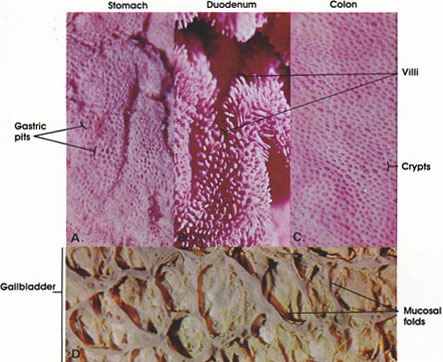

Plate 10.205 Mucosa
Ronald A. Bergman, Ph.D., Adel K. Afifi, M.D., Paul M. Heidger,
Jr., Ph.D.
Peer Review Status: Externally Peer Reviewed

Human, 10% formalin, A., B., C., carmine stain, D., unstained, 10 x.
Striking differences in the surface of the mucosa of the stomach, duodenum, colon, and gallbladder are illustrated in this plate.
The mucosal surface of the stomach contains numerous cylindrical openings, the gastric pits. The cells lining the gastric pits secrete their products into the lumina of the gastric pits and the secretions flow onto the surface of the mucosa. In contrast, the surface of the intestinal mucosa is thrown into folds (the plicae circularis), with fingerlike projections, the intestinal villi, which characterize the small intestine. The villi and mucosal folds markedly increase the surface area of the absorptive and secreting surfaces of the small intestine. The surface of the colon (large intestine) lacks villi and is pitted like the stomach. Tubular glands (crypts of Lieberkühn) extend from the surface through the thickness of the mucosae. The mucosal surface of the gallbladder is also thrown into numerous folds, giving it a honeycomb appearance. Cross sections of these same organs are seen in Plates 190, 192, 207, and 220.
Next Page | Previous Page | Section Top | Title Page
Please send us comments by filling out our Comment Form.
All contents copyright © 1995-2025 the Author(s) and Michael P. D'Alessandro, M.D. All rights reserved.
"Anatomy Atlases", the Anatomy Atlases logo, and "A digital library of anatomy information" are all Trademarks of Michael P. D'Alessandro, M.D.
Anatomy Atlases is funded in whole by Michael P. D'Alessandro, M.D. Advertising is not accepted.
Your personal information remains confidential and is not sold, leased, or given to any third party be they reliable or not.
The information contained in Anatomy Atlases is not a substitute for the medical care and advice of your physician. There may be variations in treatment that your physician may recommend based on individual facts and circumstances.
URL: http://www.anatomyatlases.org/